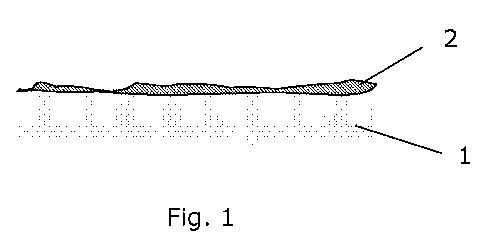Some of the information on this Web page has been provided by external sources. The Government of Canada is not responsible for the accuracy, reliability or currency of the information supplied by external sources. Users wishing to rely upon this information should consult directly with the source of the information. Content provided by external sources is not subject to official languages, privacy and accessibility requirements.
Any discrepancies in the text and image of the Claims and Abstract are due to differing posting times. Text of the Claims and Abstract are posted:
| (12) Patent Application: | (11) CA 2771371 |
|---|---|
| (54) English Title: | A WIND TURBINE COMPONENT HAVING AN EXPOSED SURFACE MADE OF A HYDROPHOBIC MATERIAL |
| (54) French Title: | COMPOSANT D'EOLIENNE COMPORTANT UNE SURFACE EXPOSEE COMPOSEE D'UN MATERIAU HYDROPHOBE |
| Status: | Deemed Abandoned and Beyond the Period of Reinstatement - Pending Response to Notice of Disregarded Communication |
| (51) International Patent Classification (IPC): |
|
|---|---|
| (72) Inventors : |
|
| (73) Owners : |
|
| (71) Applicants : |
|
| (74) Agent: | SMART & BIGGAR LP |
| (74) Associate agent: | |
| (45) Issued: | |
| (86) PCT Filing Date: | 2010-08-19 |
| (87) Open to Public Inspection: | 2011-02-24 |
| Availability of licence: | N/A |
| Dedicated to the Public: | N/A |
| (25) Language of filing: | English |
| Patent Cooperation Treaty (PCT): | Yes |
|---|---|
| (86) PCT Filing Number: | PCT/EP2010/062095 |
| (87) International Publication Number: | WO 2011020876 |
| (85) National Entry: | 2012-02-16 |
| (30) Application Priority Data: | ||||||||||||
|---|---|---|---|---|---|---|---|---|---|---|---|---|
|
The invention provides a wind turbine component having an exposed surface made of a hydrophobic material and having a surface texture providing a Water Contact Angle (CA) of at least 150. Due to the combination between a CA over 150 and the hydrophobic material, the component becomes less vulnerable to ice formation etc. The invention further provides a method of preventing ice formation, a method of reducing noise and a blade for reducing noise from a wind turbine.
L'invention se rapporte à un composant d'éolienne comportant une surface exposée composée d'un matériau hydrophobe et comportant une texture de surface offrant un angle de contact (CA) de l'eau d'au moins 150. En raison de la combinaison entre un CA supérieur à 150 et le matériau hydrophobe, le composant devient moins vulnérable à la formation de glace, etc. L'invention se rapporte en outre à un procédé consistant à empêcher la formation de glace, à un procédé consistant à réduire le bruit et à une pale destinée à réduire le bruit provenant d'une éolienne.
Note: Claims are shown in the official language in which they were submitted.
Note: Descriptions are shown in the official language in which they were submitted.

2024-08-01:As part of the Next Generation Patents (NGP) transition, the Canadian Patents Database (CPD) now contains a more detailed Event History, which replicates the Event Log of our new back-office solution.
Please note that "Inactive:" events refers to events no longer in use in our new back-office solution.
For a clearer understanding of the status of the application/patent presented on this page, the site Disclaimer , as well as the definitions for Patent , Event History , Maintenance Fee and Payment History should be consulted.
| Description | Date |
|---|---|
| Deemed Abandoned - Failure to Respond to Maintenance Fee Notice | 2016-08-19 |
| Application Not Reinstated by Deadline | 2016-08-19 |
| Inactive: Dead - RFE never made | 2016-08-19 |
| Inactive: IPC deactivated | 2016-03-12 |
| Inactive: IPC assigned | 2016-03-01 |
| Inactive: First IPC assigned | 2016-03-01 |
| Inactive: IPC assigned | 2016-03-01 |
| Inactive: IPC expired | 2016-01-01 |
| Inactive: Abandon-RFE+Late fee unpaid-Correspondence sent | 2015-08-19 |
| Amendment Received - Voluntary Amendment | 2013-09-20 |
| Letter Sent | 2012-07-19 |
| Letter Sent | 2012-07-19 |
| Inactive: Single transfer | 2012-07-05 |
| Inactive: Cover page published | 2012-04-25 |
| Inactive: First IPC assigned | 2012-03-28 |
| Inactive: Notice - National entry - No RFE | 2012-03-28 |
| Inactive: IPC assigned | 2012-03-28 |
| Application Received - PCT | 2012-03-28 |
| National Entry Requirements Determined Compliant | 2012-02-16 |
| Application Published (Open to Public Inspection) | 2011-02-24 |
| Abandonment Date | Reason | Reinstatement Date |
|---|---|---|
| 2016-08-19 |
The last payment was received on 2015-07-20
Note : If the full payment has not been received on or before the date indicated, a further fee may be required which may be one of the following
Please refer to the CIPO Patent Fees web page to see all current fee amounts.
| Fee Type | Anniversary Year | Due Date | Paid Date |
|---|---|---|---|
| Basic national fee - standard | 2012-02-16 | ||
| Registration of a document | 2012-07-05 | ||
| MF (application, 2nd anniv.) - standard | 02 | 2012-08-20 | 2012-07-27 |
| MF (application, 3rd anniv.) - standard | 03 | 2013-08-19 | 2013-07-19 |
| MF (application, 4th anniv.) - standard | 04 | 2014-08-19 | 2014-07-21 |
| MF (application, 5th anniv.) - standard | 05 | 2015-08-19 | 2015-07-20 |
Note: Records showing the ownership history in alphabetical order.
| Current Owners on Record |
|---|
| VESTAS WIND SYSTEMS A/S |
| Past Owners on Record |
|---|
| PREMKUMAR JEROMERAJAN |
| SRIKANTH NARASIMALU |